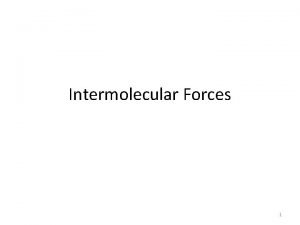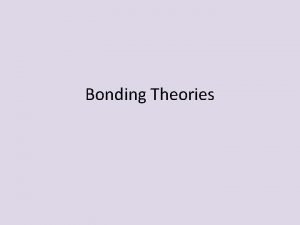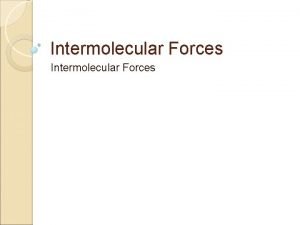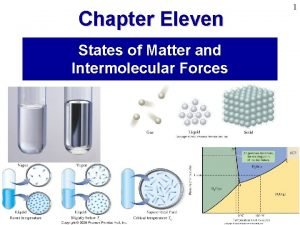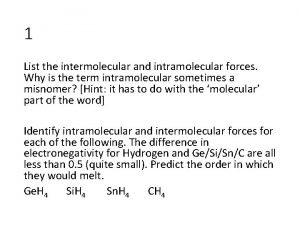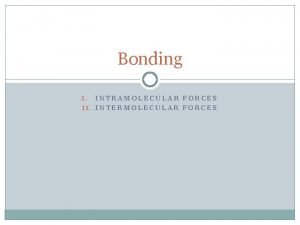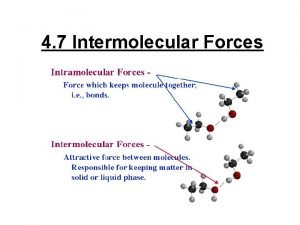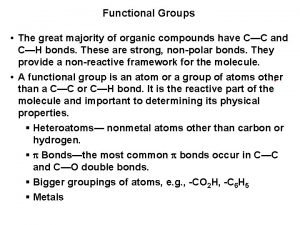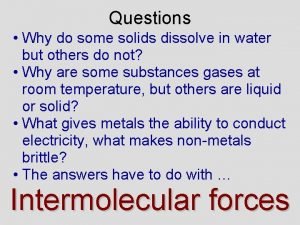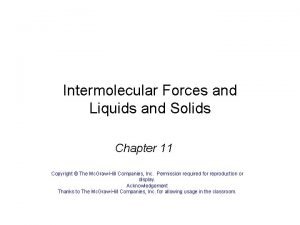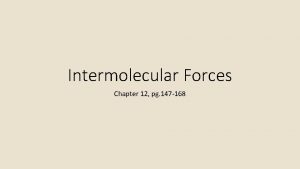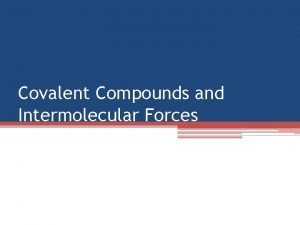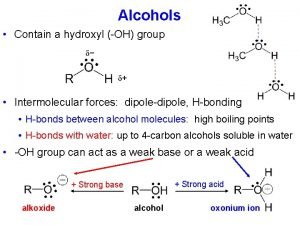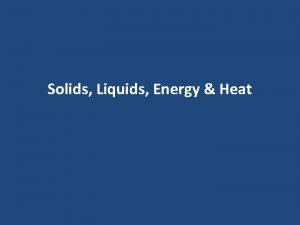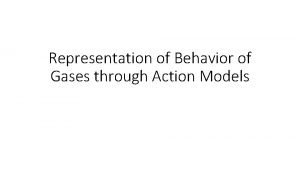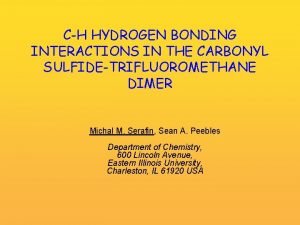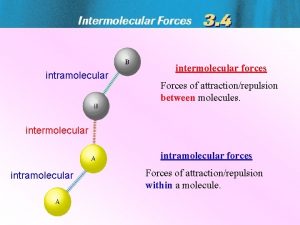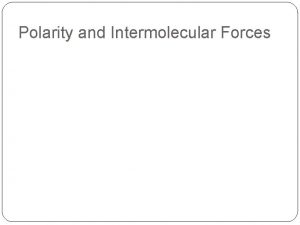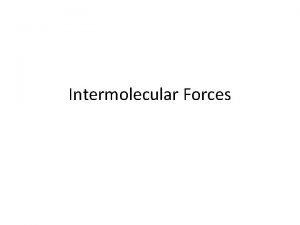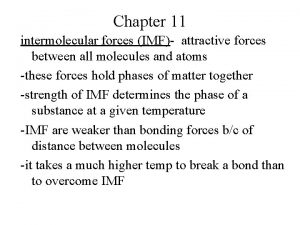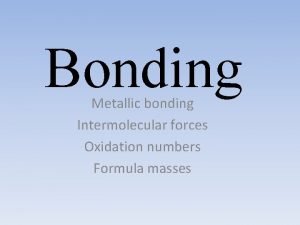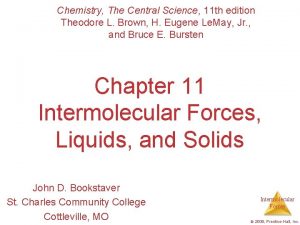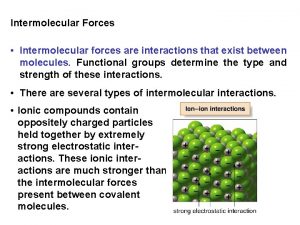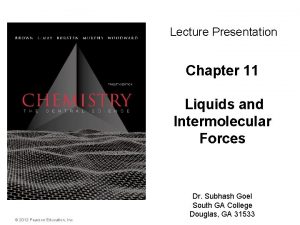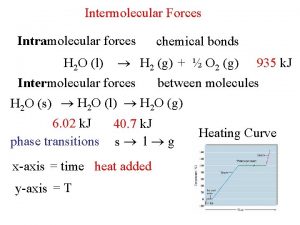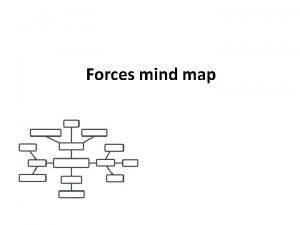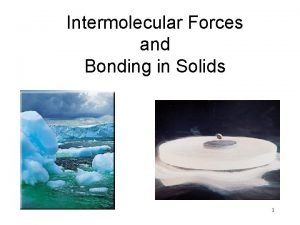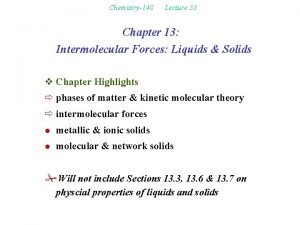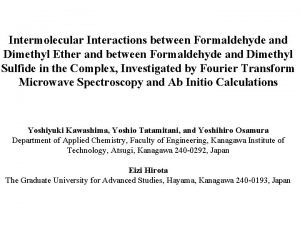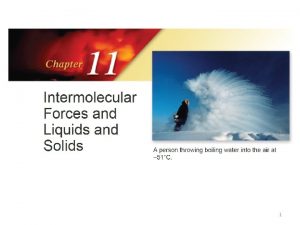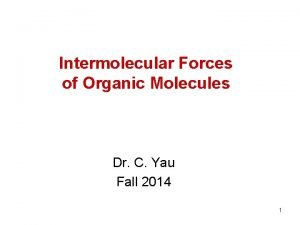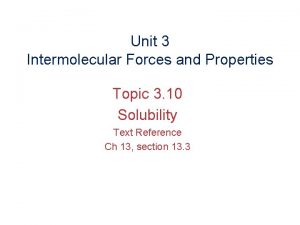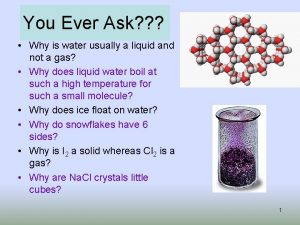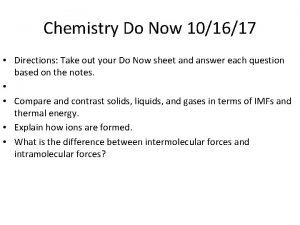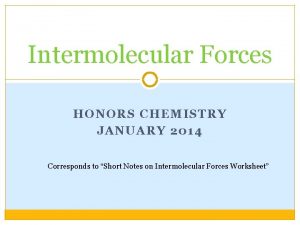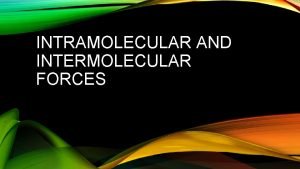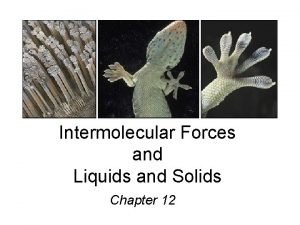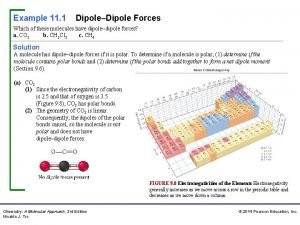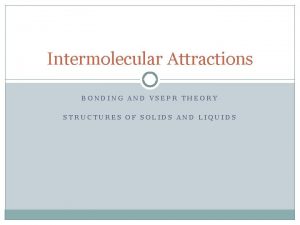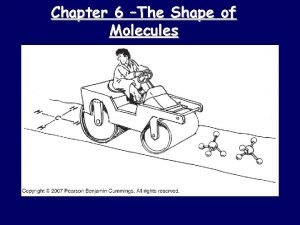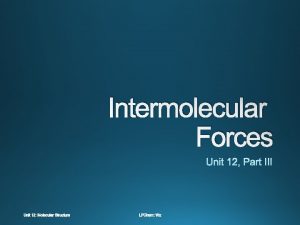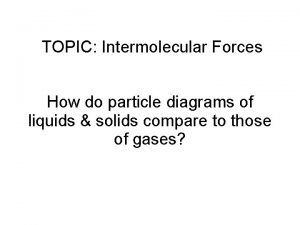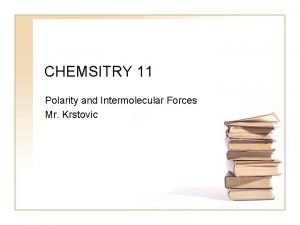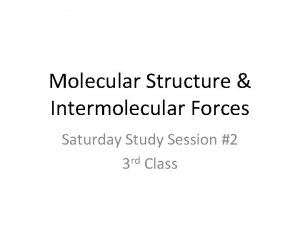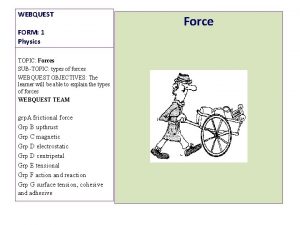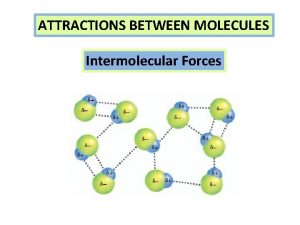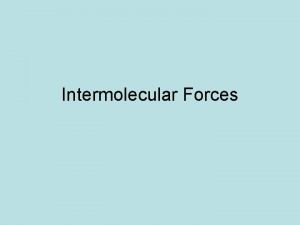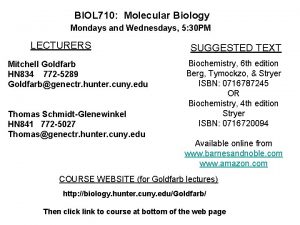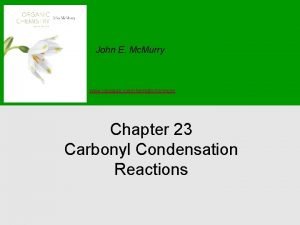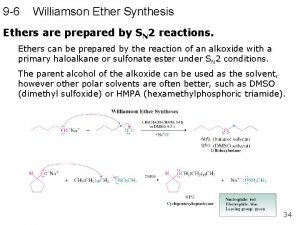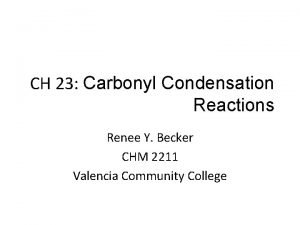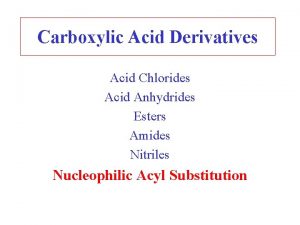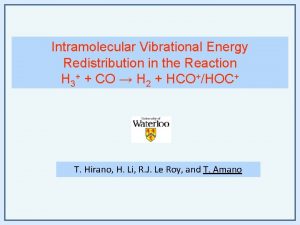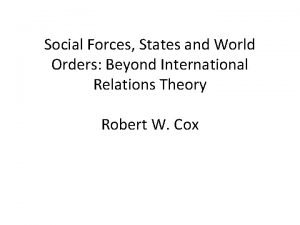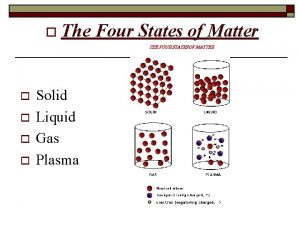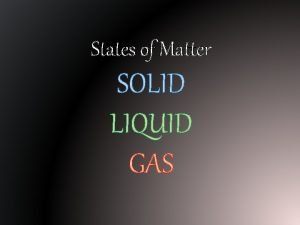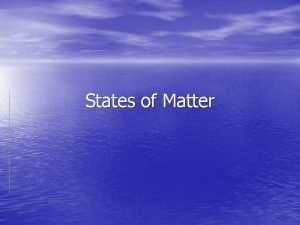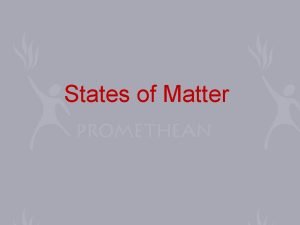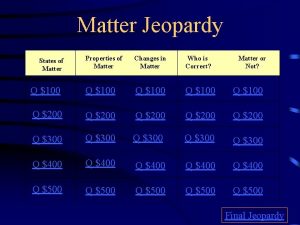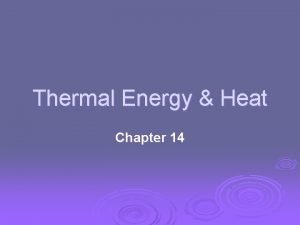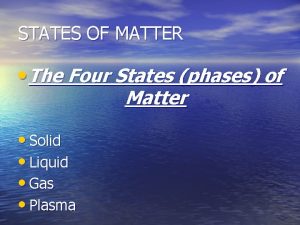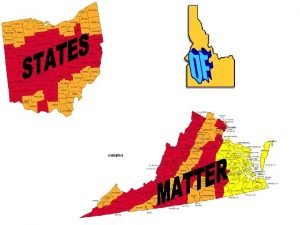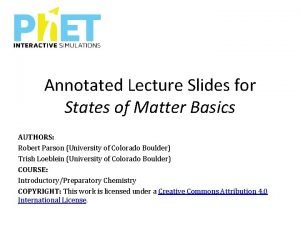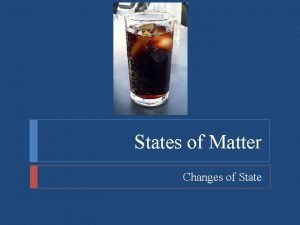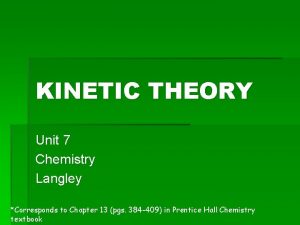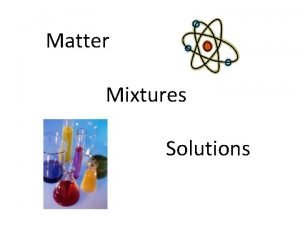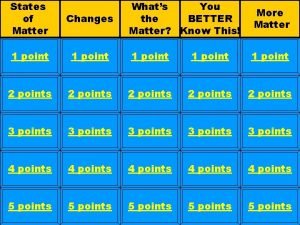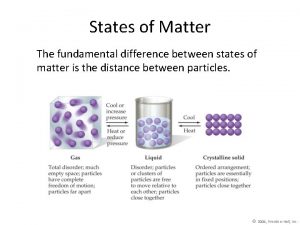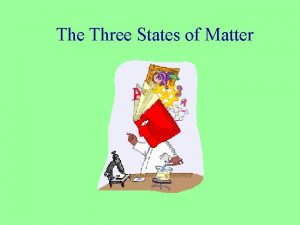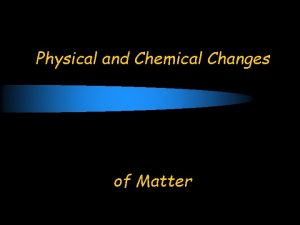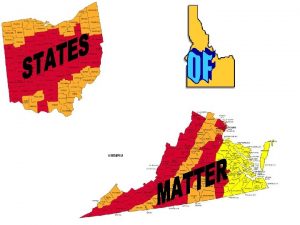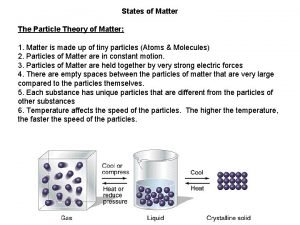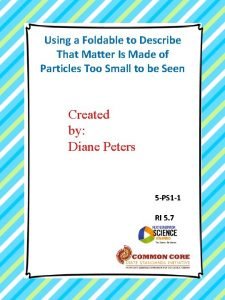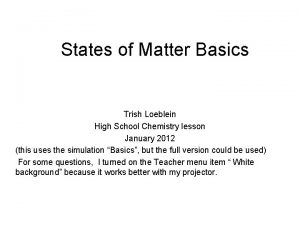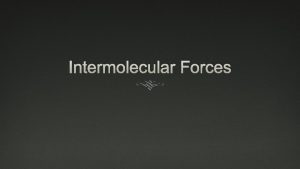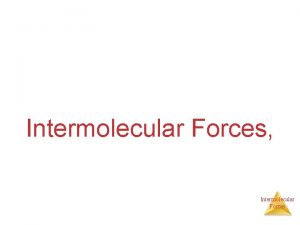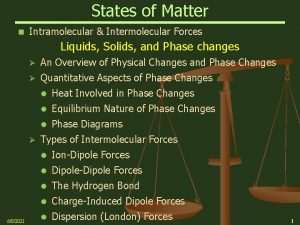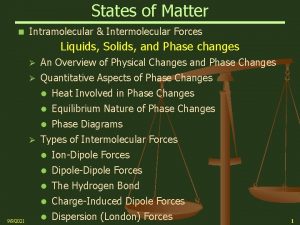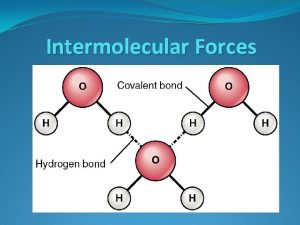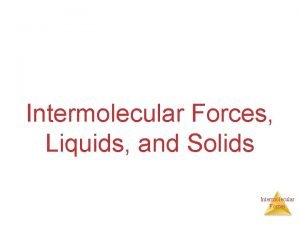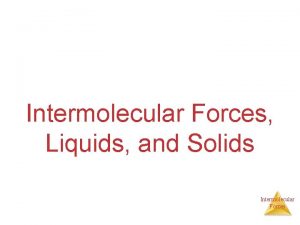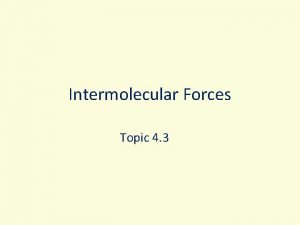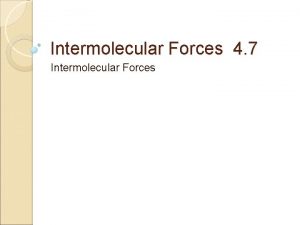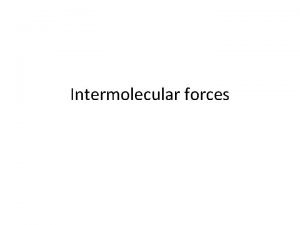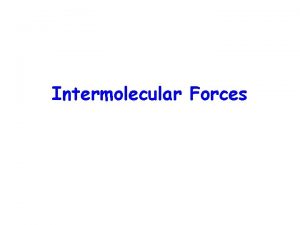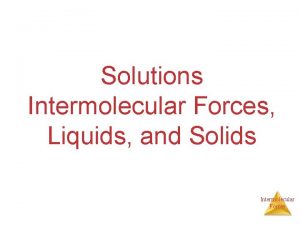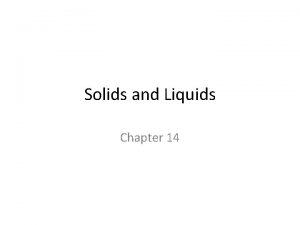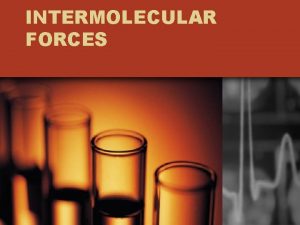States of Matter n Intramolecular Intermolecular Forces Liquids













































































































- Slides: 109

States of Matter n Intramolecular & Intermolecular Forces Liquids, Solids, and Phase changes Ø An Overview of Physical Changes and Phase Changes Ø Quantitative Aspects of Phase Changes Ø 3/10/2021 Heat Involved in Phase Changes Equilibrium Nature of Phase Changes Phase Diagrams Types of Intermolecular Forces Ion-Dipole Forces Dipole-Dipole Forces The Hydrogen Bond Charge-Induced Dipole Forces Dispersion (London) Forces 1

States of Matter Ø Ø 3/10/2021 Properties of the Liquid State Surface Tension Capillarity Viscosity The Uniqueness of Water Solvent Properties Thermal Properties Surface Properties Density of Solid and Liquid Water 2

States of Matter Ø Ø 3/10/2021 Solid State: Structure, Properties, and Bonding Structural Features of Solids Crystalline Solids Amorphous Solids Bonding in Solids Advanced Materials Electronic Materials Liquid Crystals Ceramic Materials Polymers Nanotechnology 3

States of Matter Physical States of Matter – any physically distinct, homogenous part of a system Ø Phases - Types of Physical State Gases Liquids Solids Plasma n Intermolecular and Intramolecular Forces Ø In all of the 1 st 3 phases, Electrostatic Forces among (between) the particles combine with the Kinetic Energy of the particle to create the properties of each phase as well as phase changes Vapor Pressure Boiling Point Melting Point 3/10/2021 n 4

States of Matter Comparison of gases, liquids, and solids Ø Gases Compressible fluids conforming to the shape and volume of container Molecules are widely separated Ø Liquids Relatively incompressible fluids Conform to shape of container, volume limited by surface Molecules are more tightly packed Ø Solids Nearly incompressible and rigid, maintaining their own shape and volume Molecules or ions are in close contact and do not move 3/10/2021 n 5

Representation of the States of Matter 3/10/2021 6

States of Matter n Condensation – Process by which a gas changes to a liquid n Vaporization – Process by which a liquid changes to a gas Ø Heat of Vaporization (∆Hvap) – Endothermic Enthalpy Changes n Freezing – Process by which a liquid changes to a solid n Melting (Fusion) – Process by which a solid changes to a liquid Ø n Heat of Fusion (∆Hfus) – Endothermic Enthalpy Change Sublimation – Process by which a solid changes directly

Changes of State n A change of state or phase transition is a change of a substance from one state to another gas Boiling Vaporization Sublimation Condensation Deposition liquid Freezing Melting Solid 3/10/2021 8

Phase Diagrams n A phase diagram is a graphical way to summarize the conditions under which the different states of a substance are stable Ø Ø 3/10/2021 The diagram is divided into three areas representing each state of the substance Gas Liquid Solid The curves separating each area represent the boundaries of phase changes 9

Phase Diagrams n Typical phase diagram Ø Consists of three curves that divide the diagram into regions labeled: Solid Liquid Gas C pressure B solid D liquid gas A temperature 3/10/2021 10

Phase Diagrams n Curve AB, dividing the solid region from the liquid region, represents the conditions under which the solid and liquid are in equilibrium C pressure B solid liquid D gas A temperature 3/10/2021 11

Phase Diagrams n Usually, the melting point is only slightly affected by pressure. For this reason, the melting point curve, AB, is nearly vertical pressure B solid D C liquid A gas temperature 3/10/2021 12

Phase Diagrams n If a liquid is more dense than its solid, the curve leans slightly to the left, causing the melting point to decrease with pressure C pressure B solid liquid D gas A temperature 3/10/2021 13

Phase Diagrams n If a liquid is less dense than its solid, the curve leans slightly to the right, causing the melting point to increase with pressure B solid D C liquid A gas temperature 3/10/2021 14

Phase Diagrams n Curve AC, which divides the liquid region from the gaseous region, represents the boiling points of the liquid for various pressures C pressure B solid D liquid A gas temperature 3/10/2021 15

Phase Diagrams n Curve AD, which divides the solid region from the gaseous region, represents the vapor pressures of the solid at various temperatures n The Phase change of a solid directly to a gas is referred to as “Sublimation” pressure B solid liquid D C gas A temperature 3/10/2021 16

Phase Diagrams n The curves intersect at A, the triple point, which is the temperature and pressure where three phases of a substance exist in equilibrium C pressure B solid liquid D gas A temperature 3/10/2021 17

Phase Diagrams n The temperature above which the liquid state of a substance no longer exists regardless of pressure is called the critical temperature C pressure B solid liquid D gas A temperature 3/10/2021 Tcrit 18

Practice Problem a. Position A – Gas D liquid B solid 0. 5 atm A gas C -25. 1 o. C 3/10/2021 22 o. C 21. 3 atm b. Position B – Solid c. Position C – Gas d. Position D – Since the solid – liquid line angles to the right, eventually the compound would form a solid (high pressure) 19

Bonding Forces vs. Non-Bonding Forces Intramolecular Forces (Bonding within molecules) Ø Relatively strong because charges are closer together Ø Attractions between: Anions & Cations (Ionic Bonding within molecules) Nuclei & Electron pairs (Covalent Bonding) Metal cations and Delocalized electrons (Metallic) n Intermolecular Forces (Non-Bonding between molecules) Ø Relatively Weak because charges are smaller and farther apart Ø Phase and phase changes (solid, liquid, gas) are a function of the Intermolecular forces Ø Attractions between: Molecules with partial charges or Molecules and Ions n 3/10/2021 20

Bonding Forces vs. Non-Bonding Forces Intramolecular (Bonding Forces within molecules) Intermolecular (Non- Bonding Forces between molecules) 3/10/2021 21

Intermolecular Forces n Many of the physical properties of liquids (and certain solids) can be explained in terms of the forces of attraction between molecules, that is, the Intermolecular Forces Ø Three types of forces are known to exist between neutral molecules London (or dispersion) forces – weakest (non-polar molecules) Dipole-Dipole forces – stronger (polar molecules) Hydrogen bonding – strongest (in substances where Hydrogen is directly bonded to either Oxygen, Nitrogen or Fluorine) 3/10/2021 22

London Forces n London forces are the weak attractive forces resulting from instantaneous dipoles that occur due to the distortion of the electron cloud surrounding a molecule Ø London forces: increase with molecular weight 3/10/2021 Ø The larger a molecule, the more easily the electron clould can be distorted to give an instantaneous dipole Ø All covalent molecules exhibit some London force 23

Intermolecular Forces n Van der Waals (VDW) forces – general term that includes London and Dipole-Dipole forces Ø 3/10/2021 Van der Waals forces are the weak attractive forces in a large number of substances The distance between two non-bonded atoms in “adjacent” molecules London forces are dispersion forces and are the weakest of the intermolecular forces 24

Intermolecular Forces n 3/10/2021 Van der Waals (vdw) Forces Ø Dipole – Dipole An external electric field orients gaseous polar molecules The polar molecules in liquids and solids lie near each other and their partial charges act as tiny electric fields and give rise to “Dipole-Dipole” forces Dipole-Dipole forces – slightly stronger than the London forces, but less than Hydrogen Bonding Magnitude of the Dipole-Dipole force depends on the magnitude of the molecular dipole moment 25

Dipole-Dipole Forces n Polar molecules can attract one another through Dipole-Dipole forces Ø The dipole-dipole force is an attractive intermolecular force resulting from the tendency of polar molecules to align themselves positive end to negative end Ø Polar molecules arise from the differences in the electronegativity of atoms within a molecule d+ H 3/10/2021 d Cl . . . d+ H d Cl 26

Origin of the London Force n At any instant there are more e- on one side of the Neon (Ne) atom than the other (A) Opposite ends of instantaneous dipoles attract (B) n Electrons on adjacent atoms tend to move together to create new instantaneous dipoles (C) n All molecular compounds have London attractive forces n 3/10/2021 27

Intermolecular Forces n 3/10/2021 Polarizability and Induced Dipole Forces Ø A nearby electric field can “induce” a distortion in the electron cloud: Pulling electron density toward a positive pole of the field or Pushing it away from a negative pole Ø For a “nonpolar” molecule the distortion induces a temporary dipole moment Ø For a “polar” molecular, the distortion enhances the dipole moment already present Ø Polarizability increases “Down” a group as size increases (electron cloud is easier to distort) Ø Polarizability decreases across a period because increasing Zeff makes the atoms smaller holding electrons closer 28

Hydrogen Bonding is a special dipole-dipole force that exists between a Hydrogen atom covalently bonded to a very electronegative atom with a lone pair of electrons Ø To exhibit Hydrogen Bonding, one of the following three structures must be present H O Ø 3/10/2021 H N : Only N, O, and F are electronegative enough to leave the Hydrogen nucleus exposed : Ø : n H F Hydrogen Bonding between molecules Note: Hydrogen Bonding between molecules is indicated by dotted line 29

Sample Problem Which of the following substances exhibits Hydrogen Bonding? For those that do, draw two molecules of the substance with the H bond(s) between them a. C 2 H 6 b. CH 3 OH c. CH 3 C – NH 2 n Ans: a. C 2 H 6 does not form any Hydrogen Bonds b. For CH 3 OH. The H covalently bonded to the O in one molecule forms an H-Bond to the lone pair of electrons on the O of an adjacent molecule c. For CH 3 C – NH 2. Two of these molecules can form one H bond between an H bonded to N and the O, or they can form two such bonds 3/10/2021 30

Hydrogen Bonding n Hydrogen Bonding and Boiling Point Ø Boiling points rise as molar mass increases in Group 4 A Hydrides (CH 4, Si. H 4, Ge. H 4, Sn. H 4) Ø In the other groups, the first member of each series NH 3, HF, H 2 O deviates considerably The H bonds in these substances require additional energy to break before the molecules can separate and enter the gas phase 3/10/2021 31

Hydrogen Bonding in Water 3/10/2021 32

Hydrogen Bonding n 3/10/2021 A Hydrogen atom bonded to an electronegative atom appears to be special Ø The electrons in the O-H bond are drawn to the O atom, leaving the dense positive charge of the hydrogen nucleus exposed Ø It’s the strong attraction of this exposed nucleus for the lone pair on an adjacent molecule that accounts for the strong attraction Ø A similar mechanism explains the attractions in HF and NH 3 33

Hydrogen Bonding Water (H 2 O) Molecule : O H 3/10/2021 : H H : : H H O : O H : : H H 34

Intermolecular Forces n Summary of Intermolecular Forces Ø Ions – Ionic Bonding (strongest) Ø Polar Molecules – Ion-Dipole; Dipole-Dipole, Hydrogen Bonding Ø Polar & Non-Polar Ø Non-Polar – Dipole-Induced Dipole – (London) Dispersion (weakest) n Note: Dispersion forces are present in ALL molecules 3/10/2021 35

Sample Problem The forces of attraction between molecules of I 2 are a. induced dipole–dipole attractions b. dipole–dipole attractions c. covalent bonds d. London forces e. dipole-induced dipole attractions Ans: d The I 2 molecule is non-polar no dipole-dipole no Hydrogen bonding The forces of attractions between molecules of I 2 are mostly dispersive (London forces) 3/10/2021 36

Sample Problem How many of the following compounds will exhibit Hydrogen Bonding? H 2 NNH 2 CH 3 Cl HNF 2 CH 3 OCH 3 H 2 CO a. 1 b. 2 c. 3 d. 4 e. 5 Ans: 2 H 2 NNH 2 & HNF 2 H bonded to Nitrogen (N) & Fluorine (F) 3/10/2021 37

Sample Problem What is the strongest inter-particle force in each substance? a. CH 3 OH b. CCl 4 c. Cl 2 Ans: a. Hydrogen Bonding b. Non-polar compound – Dispersion forces (The 4 Cl atoms are positioned symmetrically around the Carbon atom) c. Non-polar compound – Dispersion forces 3/10/2021 38

Sample Problem What is the strongest inter-particle force in each substance? a. H 3 PO 4 b. SO 2 c. Mg. Cl 2 Ans: a. b. c. Hydrogen Bonding Dipole-Dipole (Covalent Molecule) Ionic Bond (Metal/nonmetal forms ionic compound) 3/10/2021 39

Sample Problem Which member of each pair of compounds forms intermolecular hydrogen bonds? a. CH 3 CHOHCH 3 or b. CH 3 SCH 3 Ans: a The presence of OH group leads to formation of Hydrogen bonds a. HF or b. HBr Ans: a The presence of H attached to highly electronegative F sets up hydrogen bonds The H in HBr does not form Hydrogen bonds (Br not electronegative enough) 3/10/2021 40

Van der Waals Forces and the Properties of Liquids n In summary, Van der Waals intermolecular forces: Ø London (or dispersion) forces (weakest) Ø Dipole-dipole forces play a large role in many of the physical properties of liquids and gases. These include: vapor pressure surface tension 3/10/2021 boiling point viscosity 41

Vapor Pressure n Liquids are continuously vaporizing Ø If a liquid is in a closed vessel with space above it, a partial pressure of the vapor state builds up in this space Ø The vapor pressure of a liquid is the partial pressure of the vapor over the liquid, measured at equilibrium at a given temperature Ø Raising the temperature of a liquid increases the fraction of molecules moving fast enough to escape the liquid and decreases the fraction moving slowly enough to be recaptured The higher the temperature, the higher the vapor pressure 3/10/2021 42

Rates of Vaporization and Condensation of a Liquid Over Time Molecules in liquid are in constant motion. Some break free of intermolecular bonds and enter vapor phase In C, system comes to equilibrium where rate of condensation = rate of vaporization At this point the vapor pressure is reached 3/10/2021 43

Vapor Pressure n 3/10/2021 The vapor pressure of a liquid depends on its temperature Ø As the temperature increases, the kinetic energy of the molecular motion becomes greater, and vapor pressure increases Ø Liquids and solids with relatively high vapor pressures at normal temperatures are said to be volatile 44

Boiling Point n The temperature at which the vapor pressure of a liquid equals the pressure exerted on the liquid is called the boiling point Ø As the temperature of a liquid increases, the vapor pressure increases until it reaches external pressure (usually atmospheric pressure) Ø At this point, stable bubbles of vapor form within the liquid. This is called boiling Ø Normal Boiling Point is the boiling point at 1 atmosphere (atm) = 760 torr = 760 mm Hg 3/10/2021 45

Boiling Point n 3/10/2021 A liquid boils when the VP inside a bubble equals the external P 46

Heat of Phase Transition Heat of Vaporization n To boil a pure substance from its melting point requires an extra boost of energy to overcome intermolecular forces Ø The heat needed to boil 1 mol of a pure liquid substance is called the Heat of Vaporization and denoted by Hvap Ø For ice at the melting point, the heat of vaporization of water is 40. 66 k. J/mol Endothermic reaction requiring energy input 3/10/2021 47

Heat of Vaporization (vapor pressure & boiling point) n The heat of vaporization ( Hvap) is inversely proportional to the vapor pressure The higher the vapor pressure (low boiling point) the lower the heat of vaporization n The heat of vaporization ( Hvap) is proportional to the boiling point Liquids with low vapor pressure require more energy to invoke boiling, i. e. , they have higher boiling points 3/10/2021 48

Sample Problem Which compound should have the lowest heat of vaporization? a. C 5 H 12 b. C 6 H 14 d. C 8 H 18 e. C 8 H 16 c. C 7 H 16 Ans: a C 5 H 12 has the lowest molecular weight and should have the highest vapor pressure and, thus, the lowest boiling point Therefore, the Heat of Vaporization ( H) should be the lowest 3/10/2021 49

Heating Curve for Water 3/10/2021 50

Clausius-Clapeyron Equation n Recall: Vapor Pressure is a function of Temperature n Vapor Pressure also depends on the Intermolecular Forces present n At a given temperature molecules with weaker intermolecular forces have a higher vapor pressure and vaporize more easily n The weaker the intermolecular forces the higher the vapor pressure 3/10/2021 51

Clausius-Clapeyron Equation n 3/10/2021 The impact of the intermolecular forces produces a non-linear relationship between Vapor Pressure and Temperature 52

Clausius – Clapeyron Equation n 3/10/2021 Clausius – Clapeyron Equation Ø The non-linear relationship, as shown in the diagrams, can be expressed as a linear relationship by plotting the natural logarithm of Vapor Pressure (ln P) versus the reciprocal of the absolute temperature (o. K) 53

Clausius-Clapeyron Equation Ø A modification of the Clausius-Clapeyron equation, the two point version, allows for the description of the vapor pressure of a liquid at two different temperatures and pressures Note: R can be expressed in 2 different sets of units R = 8. 31447 J/mol K R = 0. 0821 (L atm)/(mol K) Note: 1 L • atm = 101. 3 J Units for Heat of Vaporization - k. J/mol 3/10/2021 54

Sample Problem The compound Methylchloride, CH 3 Cl, has a vapor pressure of 100 mm Hg at 210 K and 10 mm Hg a 181 K. Calculate the Heat of Vaporization (∆Hvap) of CH 3 Cl. 3/10/2021 55

Sample Problem Carbon Disulfide, CS 2, has a heat of vaporization of 29. 2 k. J/mol. At 268 K it has a vapor pressure of 100 mm. Hg. What is its vapor pressure at 301 K? 3/10/2021 56

Trouton’s Rule (Heat of Vaporization – Organic liquids) n 3/10/2021 The Heat of Vaporization ( Hvap) of an organic liquid can be estimated using Trouton’s Rule: 57

Practice Problem The liquid Tribromomethane, CHBr 3, has a vapor pressure of 751 Pa at 25 o. C and its Boiling Point is 149. 5 o. C. What is Hvap of CHBr 3? a. 13. 2 k. J/mol b. 29. 4 k. J/mol d. 59. 1 k. J/mol e. 70. 8 k. J/mol 3/10/2021 c. 37. 2 k. J/mol 58

Practice Problem The liquid Tribromomethane, CHBr 3, has a vapor pressure of 751 Pa at 25 o. C and its Boiling Point is 149. 5 o. C. What is the vapor pressure in Pa of CHBr 3 at 10 o. C? a. 2, 190 119 b. 974 c. 698 d. 339 e. Note: Hvap = 37. 2 k. J/mol from previous example 3/10/2021 59

Freezing (Melting) Point n 3/10/2021 The temperature at which a pure liquid changes to a crystalline solid, or freezes, is called the freezing point Ø The Melting Point is identical to the Freezing Point and is defined as the temperature at which a solid becomes a liquid Ø Unlike boiling points, melting points are affected significantly by only large pressure changes 60

Freezing (Melting) Point Heat of Phase Transition n 3/10/2021 To melt a pure substance at its melting point requires an extra boost of energy to overcome lattice energies Ø The heat needed to melt 1 mol of a pure substance is called the heat of fusion, Hfus Ø For ice, the heat of fusion is 6. 01 k. J/mol 61

Sample Problem How much energy in Joules (J) does it take to melt 1. 0 kg of ice at 00 C? ( Hofus = 6. 01 k. J/mol) 3/10/2021 62

Sample Problem The heat of combustion of Methane (CH 4) is shown below. How many grams of Methane does it take to melt 1. 0 kg of ice? CH 4(g) + 2 O 2(g) CO 2(g) + 2 H 2 O(l) H = -890. 0 k. J/mol. CH 4 Convert H for 1 mol CH 4 to k. J/g of CH 4 3/10/2021 63

Properties of Liquids Surface Tension n 3/10/2021 Surface tension is the energy required to increase the surface area of a liquid by a unit amount Ø Surface tension is a contractive tendency of the surface of a liquid that allows it to resist an external force Ø For example, some objects float on the surface of water, even though they are denser than water, e. g. water striders to run on the water surface Ø This property is caused by cohesion of similar molecules, and is responsible for many of the behaviors of liquids 64

Surface Tension A molecule within the bulk of a liquid is pulled equally in all directions by neighboring liquid molecules (cohesion), resulting in a net force of zero Ø At the surface of the liquid, the molecules are pulled inwards by other molecules deeper inside the liquid but are not attracted as intensely by the molecules in the neighboring medium (be it vacuum, air or another liquid) Ø As a result, there is a tendency for the surface area of the liquid to be minimized, i. e. downward pointing meniscus Ø This also explains why falling raindrops are nearly spherical, minimizing surface area Ø 3/10/2021 65

Explaining Surface Tension n Molecule on a liquid surface experiences a net force toward the interior while a molecule in the interior experiences no net force n The stronger the forces are between the particles in a liquid, the greater the surface tension n Surfactants (surface-active agents), such as soap and fat emulsifiers, decrease the surface tension of water by congregating at the surface and disrupting the H bonds 3/10/2021 66

Properties of Liquids Capillarity – The rising of a liquid through a narrow space against the pull of gravity n Water Ø In a glass capillary tube (Si. O 2), the water molecules form Hydrogen Bonds to the Oxygen atoms of the inner wall of the glass tubes Ø Water will move up the wall of the tube because the adhesive forces from the H-Bonding between the water and the wall are stronger that the cohesive forces (H-bonding) within the water Ø At the same time, the cohesive forces that give rise to surface tension pull the liquid surface taut Ø These adhesive and cohesive forces combine to raise the water level and produces the familiar concave meniscus Ø The liquid rises until gravity pulling down is balanced by the adhesive forces pulling up 3/10/2021 n 67

Capillarity n 3/10/2021 Mercury Ø The Mercury level in a glass tube immersed in a bowl of Mercury will drop below the level in the bowl Ø Mercury has a higher surface tension than water because of the stronger cohesive forces from metallic bonding Ø The cohesive forces among the Mercury atoms are much stronger than the adhesive forces (mostly dispersion) between Mercury and glass, thus the Mercury atoms tend to pull away from the walls of the glass tube Ø At the same time, the surface atoms near the glass wall are being pulled toward the interior of the Mercury by its high surface tension forcing the overall level to drop forming a convex (upward pointing) meniscus 68

Properties of Liquids Capillarity Water displays a concave meniscus in a glass tube Ø Adhesive (H-Bond) forces between H 2 O and O–Si–O groups of the glass are stronger than the cohesive forces (H-Bond) within the water n Mercury displays a convex meniscus in a glass tube Ø The cohesive (metallic bond) forces within mercury are stronger than the adhesive (dispersion) forces between the mercury and the glass n 3/10/2021 Water Mercury In a glass tube, water molecules are pulled toward the glass surface creeping up the tube, but the surface molecules are being pulled down; combined forces form a downward concave meniscus. Mercury molecules are pulled away from the glass forming an upward (convex) surface curve. The surface atoms are pulled downward dropping the level below the dish level. 69

Properties of Liquids Viscosity n 3/10/2021 Viscosity is a measure of the resistance to flow (units of kg/m • s) exhibited by all liquids and gases being deformed by either shear stress or extensional stress Ø Viscosity describes a fluid's internal resistance to flow and may be thought of as a measure of fluid friction Ø Viscosity decreases with increase temperature Ø Viscosity can be illustrated by measuring the time required for a steel ball to fall through a column of the liquid Ø Even without such measurements, you know that syrup has a greater viscosity than water 70

Van der Waals Forces and the Properties of Liquids n The molecular structure of a substance defines the intermolecular forces holding it together Ø Many physical properties of substances are attributed to their intermolecular forces Ø These properties include: Vapor Pressure Boiling Point Surface Tension Viscosity 3/10/2021 71

Van der Waals Forces and the Properties of Liquids n n n 3/10/2021 Vapor pressure (also known as equilibrium vapor pressure), is the pressure of a vapor in equilibrium with its non-vapor phases The atmospheric pressure boiling point of a liquid (also known as the normal boiling point is the temperature where the vapor pressure equals the ambient atmospheric pressure The vapor pressure of a liquid depends on intermolecular forces When the intermolecular forces in a liquid are strong, you expect the vapor pressure to be low The normal boiling point is related to vapor pressure and is lowest for liquids with the weakest intermolecular forces 72

Van der Waals Forces and the Properties of Liquids Vapor Pressure Summary: n The vapor pressure of any substance increases non-linearly with temperature according to the Clausius-Clapeyron relation n The higher the vapor pressure of a liquid at a given temperature, the lower the normal boiling point (i. e. , the boiling point at atmospheric pressure) of the liquid 3/10/2021 High VP – Weak IM Forces Low Boiling Point Low VP – Strong IM Forces High Boiling Point 73

Van der Waals Forces and the Properties of Liquids n 3/10/2021 Surface tension Ø Intermolecular forces produce attractions between the molecules of a liquid Ø Intermolecular forces exert different effects on a molecule at the surface of the liquid than on a molecule in the interior (bulk) of the liquid Ø There is a net attraction downward and move toward the interior to increase attractions and become more stable Ø As intermolecular forces between molecules increase, the apparent surface tension also increases Ø The liquid surface tends to have the smallest possible area (sphere-like) 74

Van der Waals Forces and the Properties of Liquids n 3/10/2021 Viscosity Ø A liquid’s viscosity (resistance to flow) results from intermolecular attractions that impede the ability of the molecules to slide around each other Ø Both gases and liquids flow, but liquid viscosities are much higher because intermolecular forces operate over much shorter distances Ø When molecules move faster at higher temperatures, they can overcome (reduce the effect of) intermolecular forces more easily, thus reducing the resistance to flow Ø As intermolecular forces increase, the resistance to flow (viscosity) usually increases 75

Intermolecular vs Chemical Bonding 3/10/2021 76

Properties of Liquids 3/10/2021 77

Practice Problem a. The flask with the red molecules has a lower Vapor Pressure; thus a higher boiling point due to “strong” intermolecular forces”, probably Hydrogen Bonding. The flask with the blue molecules has a higher vapor pressure and lower boiling point due to weak intermolecular forces – dispersion & dipole b. Increasing the temperature will increase the vapor pressure of both liquids, but would not change the relative vapor pressures 3/10/2021 78

Practice Problem a. Molecule is non-polar with 3/10/2021 79

Practice Problem List the following substances in order of increasing boiling point Increasing Boiling Pt D methane – -161 o. C C ethane – - 88. 6 o. C A methanol – 64. 7 o. C B ethylene glycol – 197. 2 o. C Methane & Ethane are non-polar with dispersion forces. Increasing Mol Wgt increases Boiling Point. Methanol and Ethylene Glycol both have hydrogen bonding Ethylene glycol has more Hydrogen bonding than Methanol 3/10/2021 80

Sample Problem Which of the following compounds is expected to have the HIGHEST boiling point? a. CH 3 OCH 3 b. CH 3 CH 2 OH c. CH 3 CH 2 CH 3 d. CH 3 CH 2 CH 3 e. CH 3 Cl Ans: b (Ethyl Alcohol (CH 3 CH 2 OH) – 78. 29 o. C) Ethanol has Hydrogen Bonding 3/10/2021 81

Sample Problem Which of the following compounds is expected to have the HIGHEST vapor pressure? Lowest VP? a. CH 3 CH 2 CH 3 b. CH 3 OCH 3 c. CH 3 CH 2 OH d. CH 3 CH 2 CH 3 e. CH 3 CH 2 Cl Highest Vapor Pressure (lowest boiling point) (intermolecular dipole-dipole) Ans: b. Dimethyl Ether (CH 3 OCH 3 bp -24. 8 o. C Lowest Vapor Pressure (highest boiling point) (Hydrogen Bonding) Ans: c Ethyl Alcohol (CH 3 CH 2 OH) bp 78. 29 o. C 3/10/2021 82

Solid State n A solid is a nearly incompressible state of matter with a well-defined shape n The units making up the solid are in close contact and in fixed positions n Solids are characterized by the type of force holding the structural units together n In some cases, these forces are intermolecular, but in others they are chemical bonds (metallic, ionic, or covalent) 3/10/2021 83

Solid State n From this point of view, there are four types of solids Relative Bond Energy Ø Molecular (Van der Waals forces) 0. 01 – 660 kj/mol Ø Metallic (Metallic bond) 75 – 1000 k. J/mol Ø Covalent (Covalent bond) 150 – 1100 k. J/mol Ø Ionic 3/10/2021 (Ionic bond) 400 – 4000 k. J/mol 84

Types of Solids n A molecular solid is a solid that consists of atoms or molecules held together by intermolecular forces. n A metallic solid is a solid that consists of positive cores of atoms held together by a surrounding “sea” of electrons (metallic bonding) n An ionic solid is a solid that consists of cations and anions held together by electrical attraction of opposite charges (ionic bond) n A covalent network solid is a solid that consists of atoms held together in large networks or chains by covalent bonds 3/10/2021 85

Physical Properties n Many physical properties of a solid can be attributed to its structure Melting Point and Structure 3/10/2021 Ø For a solid to melt, the forces holding the structural units together must be overcome Ø For a molecular solid, these are weak intermolecular attractions Ø Thus, molecular solids tend to have low melting points (below 300 o. C) 86

Physical Properties n 3/10/2021 Many physical properties of a solid can be attributed to its structure (con’t) Melting Point and Structure Ø For ionic solids and covalent network solids to melt, chemical bonds must be broken Ø For that reason, their melting points are relatively high Note that for ionic solids, melting points increase with the strength of the ionic bond Ionic bonds are stronger when: t The magnitude of charge is high t The ions are small (higher charge density) 87

Physical Properties n 3/10/2021 Melting Point and Structure Ø Metals often have high melting points, but there is considerable variability Ø Melting points are low for Groups IA and IIA but increase as you move into the transition metals Ø The elements in the middle of the transition metals have the highest melting points 88

Sample Problem n Which of the following compounds would be expected to have the highest melting point? a. CO 2 b. Si. O 2 d. P 4 O 10 e. N 2 O 5 c. NO 2 Ans: b CO 2, N 2 O 5 are covalent gases P 4 O 10 (mp 560 o. C) is a crystalline covalent solid Si. O 2 (mp 1650 o. C) molecules have stronger dipole-dipole intermolecular than P 4 O 10 3/10/2021 89

Physical Properties n 3/10/2021 Hardness and Structure Ø Hardness depends on how easily structural units can be moved relative to one another Ø Molecular solids with weak intermolecular attractions are rather soft compared with ionic compounds, where forces are much stronger Ø Covalent network solids are quite hard because of the rigidity of the covalent network structure Ø Molecular and ionic crystals are generally brittle because they fracture easily along crystal plane Ø Metallic solids, by contrast, are malleable 90

Physical Properties n Electrical Conductivity and Structure Ø Molecular and ionic solids are generally considered nonconductors Ø Ionic compounds conduct in their molten state, as ions are then free to move Ø Metals are all considered conductors Ø Of the covalent network solids, only graphite conducts electricity 3/10/2021 This is due to the delocalization of the resonant p electrons in graphite’s sp 2 hybridization 91

Crystalline Solids Crystal Lattices and Unit Cells n Solids can be crystalline or amorphous Ø A crystalline solid is composed of one or more crystals; each crystal has a well-defined, ordered structure in three dimensions Ø An amorphous solid has a disordered structure. It lacks the well-defined arrangement of basic units found in a crystal 3/10/2021 Examples include sodium chloride and sucrose Glass is an amorphous solid 92

Crystal Lattices n 3/10/2021 A crystal lattice is the geometric arrangement of lattice points in a crystal Ø A unit cell is the smallest boxlike unit from which you can construct a crystal by stacking the units in three dimensions Ø There are seven (7) basic shapes possible for unit cells, which give rise to seven crystal systems used to classify crystals 93

Crystal Lattices n 3/10/2021 Crystal Lattice (Con’t) Ø These seven systems can have more than one possible crystal lattice Ø A “primitive” lattice has lattice points only at the corners of each cell Ø Other lattices in the same crystal may have lattice points on the “faces” of the unit cell 94

Crystal Lattices n 3/10/2021 Crystal Lattice Ø Unit-Cell Shapes of the 7 Different Crystal Systems 95

Cubic Unit Cells n A simple cubic unit cell is a cubic cell in which the lattice points are situated only at the corners n A body-centered cubic unit cell is one in which there is a lattice point in the center of the cell as well as at the corners n A face-centered cubic unit cell is one in which there are lattice points at the center of each face of the cell as well as at the corners 3/10/2021 96

Cubic Unit Cells 3/10/2021 97

Cubic Unit Cells Space-filling representation of cubic unit cells n 1 atom/cell 2 atoms/cell 4 atoms/cell 8 x 1/8 = 1 8 x 1/8 + 1 = 2 8 x 1/8 + 6 x 1/2 = 4 3/10/2021 98

Practice Problem Shown here is a representation of a unit cell for a crystal. The orange balls are atom A, and the grey ball are atom B. a. A 9 B 6 b. Body Center Cubic 3/10/2021 99

Practice Problem Decide which substance in each of the following pairs has the lower melting point Explain how you made each choice 3/10/2021 a. KCl (775 o. C) vs Ca. O (2572 o. C), both ionic but calcium oxide is smaller and has a higher charge magnitude requiring more energy to overcome forces holding molecules together b. Carbon tetrachloride (mp -19 o. C) would have a lower melting point than hexachloroethane (mp-tp 187) because it has a lower molecular weight and less intermolecular forces to overcome c. Chromium (mp 1857 o. C) has a much high melting point than Zinc (mp 419 o. C) because of its higher ionic charges and smaller radius d. Acetic acid (mp 16. 5 o. C) has a high mp than Ethyl chloride (mp -139 o. C) because hydrogen bonds require more energy to overcome the forces holding the molecules together 100

Crystal Defects n 3/10/2021 There are principally two kinds of defects that occur in crystalline substances Ø Chemical impurities, such as in rubies, where the crystal is mainly aluminum oxide with an occasional Al 3+ ion replaced with Cr 3+, which gives a red color Ø Defects in the formation of the lattice. Crystal planes may be misaligned, or sites in the crystal lattice may remain vacant 101

Calculations Involving Unit Cell Dimensions n 3/10/2021 X-ray diffraction is a method for determining the structure and dimensions of a unit cell in a crystalline compound Ø Once the dimensions and structure are known, the volume and mass of a single atom in the crystal can be calculated Ø The determination of the mass of a single atom gave us one of the first accurate determinations of Avogadro’s number 102

Sample Problem Li. Cl crystallizes in a face-centered cubic structure. The unit cell length is 5. 14 x 10 -8 cm. The chloride ions are touching each other along the face diagonal of the unit cell. The Li+ ions fit into the holes between the chloride ions. How many Li+ ions are there in this unit cell? Each cell contains 12 ¼ Li+ ions plus 1 whole Li+ ion 12 x 1/4 + 1 = 4 (total) How many Cl- ions are there in the cell? Li Each cell contain 8 1/8 Cl- ions and 6 ½ Cl- ions 8 x 1/8 + 6 x 1/2 = 4 (total) 3/10/2021 103

Sample Problem Li. Cl crystallizes in a face-centered cubic structure. The unit cell length is 5. 14 x 10 -8 cm. The chloride ions are touching each other along the face diagonal of the unit cell. The Li+ ions fit into the holes between the chloride ions. What is the mass of the Li. Cl cell? 3/10/2021 104

Sample Problem Li. Cl crystallizes in a face-centered cubic structure. The unit cell length is 5. 14 x 10 -8 cm. The chloride ions are touching each other along the face diagonal of the unit cell. The Li+ ions fit into the holes between the chloride ions. What is the density of Li. Cl? 3/10/2021 105

Sample Problem Li. Cl crystallizes in a face-centered cubic structure The unit cell length is 5. 14 x 10 -8 cm The Chloride ions are touching each other along the face diagonal of the unit cell The Li+ ions fit into the holes between the Chloride ions What is the radius of the Cl- ion in meters? (hint: in a square, Diagonal = cell length (S) x √ 2 L i 3/10/2021 106

Summary Equations 3/10/2021 107

Equation Summary R = 8. 31447 J/mol K R = 0. 0821 (atm L)/(mol K) 3/10/2021 108

Equation Summary 3/10/2021 109
 Intermolecular vs intramolecular
Intermolecular vs intramolecular Intermolecular vs intramolecular
Intermolecular vs intramolecular Intramolecular forces vs intermolecular forces
Intramolecular forces vs intermolecular forces Similarities of intermolecular and intramolecular forces
Similarities of intermolecular and intramolecular forces Types of van der waals forces
Types of van der waals forces Intramolecular vs intermolecular forces
Intramolecular vs intermolecular forces Intermolecular forces present in hbr
Intermolecular forces present in hbr Chapter 11 - states of matter: liquids and solids
Chapter 11 - states of matter: liquids and solids Intermolecular forces in matter
Intermolecular forces in matter List of intermolecular forces
List of intermolecular forces Intramolecular forces
Intramolecular forces Intramolecular forces
Intramolecular forces Intramolecular interactions
Intramolecular interactions Functional groups and intermolecular forces
Functional groups and intermolecular forces London dispersion forces induced dipole
London dispersion forces induced dipole London dispersion force
London dispersion force Hbr intermolecular forces
Hbr intermolecular forces Interatomic and intermolecular forces
Interatomic and intermolecular forces Coh2 intermolecular forces
Coh2 intermolecular forces Strengths of intermolecular forces
Strengths of intermolecular forces Butanal isomers
Butanal isomers 3 types of intermolecular forces
3 types of intermolecular forces Poem about intermolecular forces
Poem about intermolecular forces Carbonyl sulfide intermolecular forces
Carbonyl sulfide intermolecular forces Sucrose intermolecular forces
Sucrose intermolecular forces Intermolecular forces ap chemistry
Intermolecular forces ap chemistry Ion dipole forces example
Ion dipole forces example Dipole induced dipole interaction
Dipole induced dipole interaction Polarity and intermolecular forces
Polarity and intermolecular forces Phthatic
Phthatic Vander waals force
Vander waals force Intermolecular forces
Intermolecular forces Type of intermolecular forces
Type of intermolecular forces Viscosity and intermolecular forces
Viscosity and intermolecular forces 3 types of intermolecular forces
3 types of intermolecular forces Types of intermolecular forces
Types of intermolecular forces Capillary action
Capillary action Surface tension intermolecular forces
Surface tension intermolecular forces Intermolecular forces comic strip
Intermolecular forces comic strip Mind map of friction
Mind map of friction Ionic forces of attraction
Ionic forces of attraction Intermolecular forces
Intermolecular forces Intermolecular forces
Intermolecular forces Intermolecular forces
Intermolecular forces Capillary action
Capillary action Hco2h intermolecular forces
Hco2h intermolecular forces Unit 3 intermolecular forces and properties
Unit 3 intermolecular forces and properties London dispersion forces induced dipole
London dispersion forces induced dipole Intermolecular forces capillary action
Intermolecular forces capillary action Strongest to weakest intermolecular forces
Strongest to weakest intermolecular forces How do intermolecular forces affect solvation
How do intermolecular forces affect solvation Electronegativity and intermolecular forces
Electronegativity and intermolecular forces Surface tension intermolecular forces
Surface tension intermolecular forces Intermolecular forces in sugar
Intermolecular forces in sugar Ch2cl intermolecular forces
Ch2cl intermolecular forces Ch2cl intermolecular forces
Ch2cl intermolecular forces Bi3 intermolecular forces
Bi3 intermolecular forces Intermolecular forces symbol
Intermolecular forces symbol Intermolecular forces
Intermolecular forces Intermolecular forces
Intermolecular forces Cnh5 intermolecular forces
Cnh5 intermolecular forces Strongest intermolecular force
Strongest intermolecular force Intermolecular forces webquest
Intermolecular forces webquest Molecules attraction
Molecules attraction Geckos and intermolecular forces
Geckos and intermolecular forces Molecular biology
Molecular biology Intramolecular claisen condensation
Intramolecular claisen condensation Williamson ether synthesis
Williamson ether synthesis Intramolecular claisen condensation
Intramolecular claisen condensation Acid anhydride to amide
Acid anhydride to amide Intramolecular vibrational energy redistribution
Intramolecular vibrational energy redistribution What is like parallel force
What is like parallel force What is constructive force
What is constructive force The forces shown above are pushing/pulling forces
The forces shown above are pushing/pulling forces Force and motion
Force and motion Net force
Net force Social forces states and world orders
Social forces states and world orders Oo solid
Oo solid Southern vs northern states
Southern vs northern states Chapter 10 review states of matter section 4
Chapter 10 review states of matter section 4 Thermal energy in states of matter
Thermal energy in states of matter States of matter
States of matter Vocab
Vocab 4 phases of matter
4 phases of matter Phase change concept map
Phase change concept map Properties of matter jeopardy
Properties of matter jeopardy Use of heat
Use of heat How does the constitution guard against tyranny
How does the constitution guard against tyranny Solid liquid gas venn diagram
Solid liquid gas venn diagram Four phases of matter
Four phases of matter Five states of matter
Five states of matter Gray matter and white matter
Gray matter and white matter Koosha golmohammadi
Koosha golmohammadi Section 1 composition of matter
Section 1 composition of matter States of matter basics
States of matter basics Changing state
Changing state 5 states of matter
5 states of matter States of matter solid liquid gas
States of matter solid liquid gas Better matter
Better matter Chapter 2 section 1 classifying matter answer key
Chapter 2 section 1 classifying matter answer key The fundamental difference between states of matter is the
The fundamental difference between states of matter is the The kinetic theory of matter states that
The kinetic theory of matter states that States of matter objectives
States of matter objectives 4 fe
4 fe Four states of matter
Four states of matter Chemical equations with states of matter
Chemical equations with states of matter Classification of matter section 1 composition of matter
Classification of matter section 1 composition of matter States of matter foldable
States of matter foldable Energy naturally flows from warmer matter to cooler matter
Energy naturally flows from warmer matter to cooler matter Phet states of matter basics
Phet states of matter basics



